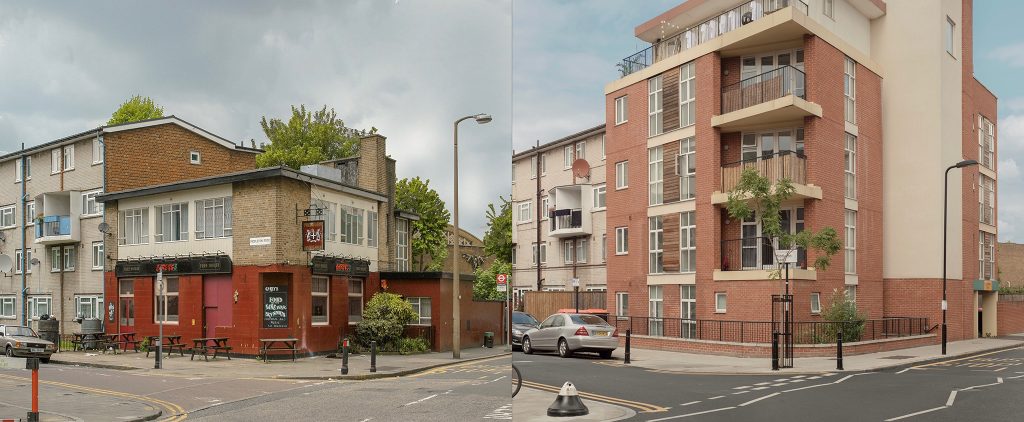My work on community engagement with urban regeneration involves working closely with communities and learning about the proposed developments and their impact on these communities and the environment. Making images is a part of this process. These images are part of both relationship making and the process of identification of themes and approaches. There are messages in this work, but as photography is being used heuristically (as part of the process of investigation, not necessarily in the production of final outcomes) these messages are formative and transitory. Over the course of this module, I am developing my own artistic response the the contexts I am exploring.
Photographic work in these contexts (urban regeneration and gentrification) has largely focused on the experiences of members of the communities affected by the changes (for instance, in different ways, Zed Nelson’s and Tom Hunter’s Hackney portraits and Emma Blau’s work with residents of an estate in West London, or Dana Lixenberg’s work with residents of the Imperial Courts social housing project in Los Angeles), or on the impact on the built environment of urban development (for instance, Metropole by Lewis Bush looking at developments around central London and Chris Dorley-Brown‘s studies of areas of East London over time).


My work is taking a different direction. A dominant concern is the disempowerment of communities in the urban development process. Producing images with and for communities, to be used in advocacy and campaigning, addresses this in part in terms of action (with much to learn, in terms of both theory and practice, from Martha Rosler’s ‘If you lived here …’ project, see comprehensive account and analysis in Wallis, 1991). It leaves open, though, how my own image making will address this issue. Invoking the passage of time, the interaction of the human and natural in the environment and the social and environmental impact of current and future urban development. The use of digital manipulation, and animation, in my recent work has led me to look at how others have addressed these issues digitally, whilst still aspiring to produce artifacts alongside images (and images as artifacts). Amongst the artists discussed in Wolf’s (2010) survey of photography in a digital age, the passage of time is addressed through composites by Jason Salavon and mapping and algorithmically generated images by Siebren Versteeg.

To loop back to the initial question for this week’s reflection, I do aspire for there to be multiple messages in my work, whilst recognising, indeed celebrating, the lack of control that the artist has in the reading of their work, and the possibility that it will produce new meanings for those who engage with the work (see Barthes, 1967, and Foucault, 1977, for critical consideration of the notion of authorship). Intent enhances the coherence and direction of the work, but does not determine its meaning or constrain its potential messages. The process that I am developing acknowledges, and, I hope, is able to be animated by, that indeterminacy. Prevailing social, cultural and economic conditions will always entail that there are perceived better and worse (in the moment, readable and incomprehensible) carriers for these messages, which makes it important to position the work, and index its intent, in relation to other work in the field (see Bourdieu, 1990, for discussion of the notion of field with respect to photographic practice).
References
Barthes, R. 1967. ‘The Death of the Author.’ Aspen: The Magazine in a Box. 5+6. UbuWeb: http://www.ubu.com/aspen/aspen5and6/index.html [accessed 25.03.19]
Bourdieu, P. 1990. Photography: A Middle-brow Art. Cambridge: Polity Press.
Foucault, M. 1977. ‘What Is an Author?’ In D. F. Bouchard (ed.) Language, Counter-Memory, Practice: Selected Essays and Interviews. Ithaca, NY: Cornell University Press. 113-38.
Wallis, B. (ed.).1991. If you lived here : the city in art, theory, and social activism. Seattle: Bay Press.
Wolf, S. 2010. The Digital Eye: Photographic Art in the Digital Age. Munich: Prestel Verlag.
